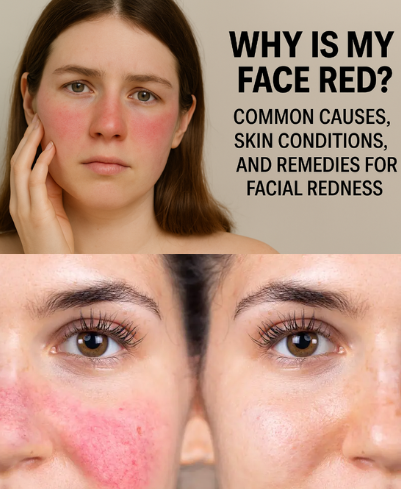
Understanding Sudden Facial Redness
Waking up with red, flushed skin or suddenly noticing patches of irritation on your face can be unsettling. Facial redness doesn’t always have a single cause—it can stem from everyday habits, environmental triggers, or underlying skin conditions. The key to finding relief lies in identifying what’s causing your skin to react.
In this guide, we’ll break down the most common causes of facial redness, highlight skin conditions you should know about, and share both preventative measures and treatment options.
General Causes of Facial Redness
Your skin can turn red for several reasons. Some are mild and temporary, while others may require a closer look. Here are five of the most common culprits:
1. Over-Exfoliation
Exfoliation is meant to refresh your skin by removing dead cells, but too much of it can backfire. Over-exfoliating strips away your skin’s protective barrier, leaving it raw, dehydrated, and inflamed.
Solution: Stick to exfoliating no more than twice a week and use hydrating moisturizers with ceramides or hyaluronic acid to restore balance.
2. Acne and Scarring
Inflamed pimples and acne scars often appear as red spots. The redness comes from clogged, infected follicles and the body’s inflammatory response. Even after breakouts heal, discoloration can linger.
Solution: Incorporate targeted acne treatments, and use calming serums to minimize post-acne redness.
3. Sun Damage
UV exposure weakens collagen and elastin, enlarging facial blood vessels and causing spidery red veins, especially around the nose and cheeks.
Solution: Apply SPF 50 daily—rain or shine—to prevent long-term redness and sun-related skin damage.
4. Allergic Reactions
Sometimes redness comes from something new—like a skincare product or a food allergy. Strong ingredients such as retinol, AHAs, or BHAs can trigger temporary irritation if used incorrectly.
Solution: Patch-test new products and avoid known allergens.
5. Alcohol Consumption
Alcohol dilates blood vessels, often leading to facial flushing and redness. For those with alcohol intolerance, even small amounts can cause swelling and irritation.
When Redness Signals a Skin Condition
Not all redness is surface-level. In some cases, it can be tied to skin conditions that need professional attention.
Rosacea
This chronic inflammatory condition is marked by recurring redness, visible veins, rashes, and even thickened skin. Flare-ups are often triggered by stress, heat, or sun exposure.
Video : Facial Redness: Common Causes and When to Seek Medical Care | BuoyHealth.com
Eczema (Atopic Dermatitis)
Eczema causes patches of dry, itchy, red skin that may crack or bleed. Flare-ups often appear on the face and can worsen with stress or irritants.
Psoriasis
This immune-driven condition speeds up skin cell turnover, leaving thick, red patches with silvery scales. It can appear on the face, scalp, or body.
Contact Dermatitis
When your skin reacts to an allergen or irritant, it may swell, itch, and turn red. Fragrances, detergents, or harsh skincare products are common triggers.
How to Prevent Facial Redness
The best strategy is prevention—minimizing triggers before redness appears. Here’s how:
- Limit alcohol: Reducing intake can prevent blood vessel dilation and flare-ups.
- Wear sunscreen: Daily SPF 50 protects against redness caused by UV damage.
- Adjust daily habits: Cut back on spicy foods, avoid hot baths, and stay clear of harsh skincare ingredients.
- Improve your diet: Reduce trigger foods like garlic, onions, and processed spicy dishes that worsen redness.
- Moisturize regularly: Hydrating products with ceramides, niacinamide, or hyaluronic acid help strengthen your skin barrier.
Home Remedies vs. Skincare Products
Both natural remedies and store-bought products have their place in calming redness.
Home Remedies:
- Aloe vera gel (soothes inflammation)
- Honey (antimicrobial and calming)
- Chamomile tea bags (anti-inflammatory)
- Coconut oil or yogurt masks (gentle hydration)
Skincare Products:
- Niacinamide (calms redness and strengthens skin barrier)
- Azelaic acid (reduces inflammation and discoloration)
- Salicylic acid (controls acne-related redness)
- Vitamin C (brightens and supports collagen)
For mild redness, home remedies may suffice. For chronic conditions, dermatologist-recommended products are the safer bet.
Quick Fixes for Overnight Relief
While there’s no magic solution to erase redness overnight, you can reduce its appearance temporarily:
- Cool compress: Use ice cubes wrapped in cloth or splash your face with cold water to calm blood vessels.
- Hydrate well: Drinking plenty of water flushes toxins and reduces inflammation.
- Soothing masks: Apply a calming serum mask or a DIY yogurt-and-honey mask before bed.
These quick remedies won’t cure underlying issues but can help you wake up with less noticeable redness.
Video : Skin Flushing or Blushing: Everything You Need To Know
Final Thoughts
Facial redness is more than just a cosmetic concern—it’s your skin signaling that something is off. From over-exfoliation and sun damage to chronic conditions like rosacea and eczema, the causes vary widely. The key to managing it lies in prevention, consistent care, and knowing when to seek professional help.
By avoiding common triggers, using hydrating skincare, and protecting your skin daily, you can calm redness and restore a healthier, more even-toned complexion.


